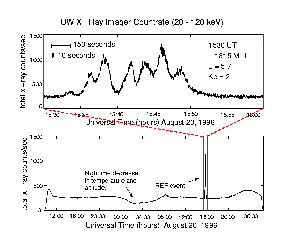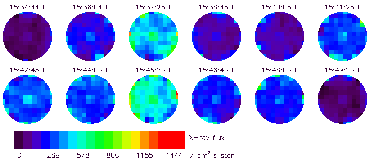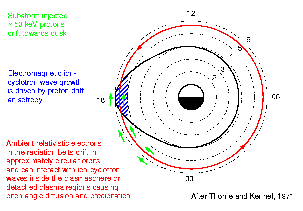Balloon-Borne X-Ray Observations of
Relativistic Electron Precipitation
This web page shows several figures from posters that were presented
at the 1997 and 1998 American Geophysical Union meetings.
The 1997 AGU abstract
summarizes
observations by the X-ray imager
and the 1998
AGU abstract
proposes a model to explain these observations.
A
Geophysical Research Letters
paper also describes the
preliminary
observations.
Introduction
The INTERBOA96 (Balloon
Observations of Aurora) campaign launched
three stratospheric balloons from Kiruna, Sweden, in August 1996. Launch
times were chosen to coordinate with geomagnetic activity and ISTP
satellite positions.
Balloon-borne instruments included the
X-ray imager,
X-ray
spectrometers, magnetometers and electric field probes.
On August 20, 1996 at 1530 UT (1815 MLT, L ~ 5.7), the balloon-borne
X-ray instruments observed a burst of X-rays with energies > 1 MeV
which are best accounted for by atmospheric bremsstrahlung from
mono-energetic 1.7 MeV precipitating electrons.
The geophysical condition was quiet, with Kp ~ 2. A small substorm was
observed ~24 minutes before the X-ray event by the Polar UVI and by
the LANL geosynchronous satellites.
Observations
|

|
Figure 1.
The measured count rate from the UW X-ray imager for 20-120 keV
X-rays, over the entire flight and during the REP event. The
countrate
shows large variations with periodicity of about 150 seconds and smaller
variations with periodicity of about 10 seconds.
|
|

|
Figure 2.
80-second images from the X-ray imager show no significant spatial structure,
indicating that variations in flux
are a temporal effect rather than a spatial one. The flux brightens
uniformly across the field of view (50 km at 60 km altitude) rather
than moving in and out of the image.
|
|

|
Figure
3.
X-ray energy spectra taken by the Berkeley germanium
spectrometer. Note the significant flux of X-rays at
MeV energies. The spectra harden slightly after 15:42 UT. The solid lines
show the fit obtained from bremsstrahlung calculations with a model
input of mono-energetic 1.7 MeV X-rays [Foat, et al., First Detection of
a Terrestrial MeV X-ray Burst, Geophys. Res. Letters, 25, 1998]. |
A Possible Explanation
|

|
Figure
4. The X-ray observations
and coincident observations of a nightside substorm can be explained by
interaction of relativistic electrons with electromagnetic ion-cyclotron
waves. The wave growth is driven by hot (~50 keV) protons drifting from the
substorm injection into regions of high-density such as the plasmasphere or
detached plasma regions. Calculations of wave growth and resonant electron
energies show that this model provides a reasonable explanation for the
observed energies, spectral characteristics and spatial localization of the
event. This cartoon illustrates the main features of the model. |
Geophysics
Main Page |
Space Physics
| Balloon Experiments
Kirsten Lorentzen / 4 December 1998 /
kirsten@geophys.washington.edu



